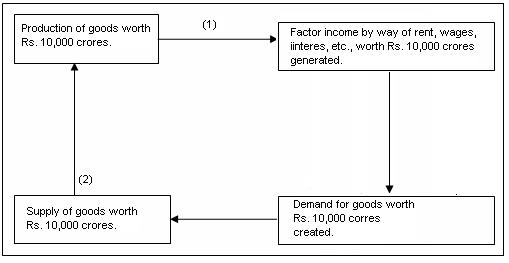Says Law of Market
Says Law of Market Assignment Help | Says Law of Market Homework Help
Say’s Law of Market
J.B. Say, a French economist, introduced a theory of market which states that “supply creates its own demand”. Since every supply of output creates an equivalent demand for output, there can never be a problem of general over-production or under-production. While the output of an individual goods may be larger or smaller then its demand, the aggregate supply of goods and services in the economy will always be equal to the aggregate demand.
For example, and economy in an accounting year produces goods and services worth Rs. 10,000 crores. Since any production activity requires the services of the factors of production, factor income worth Rs. 10,000 crores gets generated in the economy. This factor income can be utilized to buy goods and services, and therefore, an aggregate demand worth Rs. 10,000 crores is created. This is how supply creates its own demand.
This can be illustrated in the form of a chart:

In production of goods worth Rs. 10,000 crores creates, on the one hand, the income worth Rs. 10,000 crores, and on the other, the goods worth Rs. 10,000 crores are offered for sale.
Symbolically,
ΔO = ΔY = ΔE
Where ΔO = Change in output
ΔY = Change in income, and
ΔE = Change in intended expenditure.
Say’s law was initially formulated for a barter economy in which goods were exchanged for goods, and later on, the law became operative in the money economy as well.
For example, and economy in an accounting year produces goods and services worth Rs. 10,000 crores. Since any production activity requires the services of the factors of production, factor income worth Rs. 10,000 crores gets generated in the economy. This factor income can be utilized to buy goods and services, and therefore, an aggregate demand worth Rs. 10,000 crores is created. This is how supply creates its own demand.
This can be illustrated in the form of a chart:
In production of goods worth Rs. 10,000 crores creates, on the one hand, the income worth Rs. 10,000 crores, and on the other, the goods worth Rs. 10,000 crores are offered for sale.
Symbolically,
ΔO = ΔY = ΔE
Where ΔO = Change in output
ΔY = Change in income, and
ΔE = Change in intended expenditure.
Say’s law was initially formulated for a barter economy in which goods were exchanged for goods, and later on, the law became operative in the money economy as well.
Assumptions of the Say’s Law of Market
Say’s law of market is based on the following assumptions:
(i) Perfect competition prevails in both factor market and the product market.
(ii) There is optimum allocation of resources.
(iii) The size of market is capable of expansion
(iv) The amount of labour and capital can be raised in a market economy based on price mechanism.
(v) The government adopts a ‘hands off’ or ‘non-intervention’ policy. The system works
automatically with the help of price mechanism.
(vi) All savings are automatically invested. Equality between savings and investment is brought about by changes in the rate interest.
(vii) Flexibility in the wage rate.
(i) Perfect competition prevails in both factor market and the product market.
(ii) There is optimum allocation of resources.
(iii) The size of market is capable of expansion
(iv) The amount of labour and capital can be raised in a market economy based on price mechanism.
(v) The government adopts a ‘hands off’ or ‘non-intervention’ policy. The system works
automatically with the help of price mechanism.
(vi) All savings are automatically invested. Equality between savings and investment is brought about by changes in the rate interest.
(vii) Flexibility in the wage rate.
Implications of Say’s Law
(i) In the long-run a free market economy attains equilibrium at the full employment level.
(ii) Since equality between aggregate demand and aggregate supply is automatically attained, there is no need for government intervention.
(iii) Since supply creates its own demand, there is no possibility of over-production and under-production.
(iv) So long as there exists unemployed resources in the economy, it is profitable to employ them because they can pay for themselves. When the unemployed resources are employed, they lead to more production, which covers their own cost.
(v) Any imbalance between saving and investment could be corrected by changing the rate of interest.
(vi) In case there is unemployment in the labour market, it could be corrected of the workers are prepared to accept a wage rate equal to their marginal productivity.
For more help in Say’s Law of Market click the button below to submit your homework assignment
(ii) Since equality between aggregate demand and aggregate supply is automatically attained, there is no need for government intervention.
(iii) Since supply creates its own demand, there is no possibility of over-production and under-production.
(iv) So long as there exists unemployed resources in the economy, it is profitable to employ them because they can pay for themselves. When the unemployed resources are employed, they lead to more production, which covers their own cost.
(v) Any imbalance between saving and investment could be corrected by changing the rate of interest.
(vi) In case there is unemployment in the labour market, it could be corrected of the workers are prepared to accept a wage rate equal to their marginal productivity.
For more help in Say’s Law of Market click the button below to submit your homework assignment